Highway 289 is a designation for two north–south state highways in north central Arkansas. A southern route of 4.93 miles (7.93 km) runs north from Highway 69B (AR 69B) at Sage to Zion. A second route of 37.89 miles (60.98 km) begins at Highway 56 in Franklin and runs north to Highway 9 in Mammoth Spring.

The Abial Cushman Store is a historic commercial building at 2766 Lee Road in Lee, Maine. Built in 1840, it is one of the rural community's few surviving 19th-century commercial buildings, and one of its few examples of Greek Revival architecture.
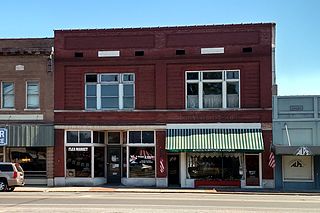
The Joe P. Eagle and D. R. Boone Building is a historic commercial building at 105-107 West Front Street in downtown Lonoke, Arkansas. It is a two-story red brick building, with a sloping flat roof obscured by parapet, and a brick foundation. It is divided into two sections, articulated by brick pilasters. The left half has an original storefront on the first floor, with plate glass display windows flanking a recessed entrance, while the right half has a more modern (1960s) appearance, with a central display window, with the store entrance on the right and a building entrance to the upper floor on the left. The second-floor on both halves has tripled sash windows, the center one larger, all topped by transom windows. The building was designed by architect Charles L. Thompson and built in 1905.

Turkey Creek School is a former school building located along Arkansas Highway 9 in Stone County, Arkansas. It is a single-story wood frame structure, with a metal gable roof, weatherboard siding, and a stone foundation. The north facade has a symmetrical pair of entrances with simple trim, and the sides have five sash windows. Although it was built in 1925, the school resembles much older rural schoolhouses. It was used as a school until 1949, and now serves as a local community building.
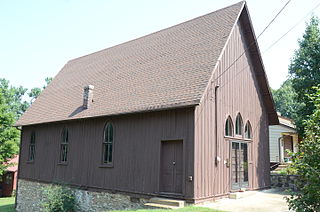
Saint Andrew's Episcopal Church is a historic church at Sixth and Main Street in Mammoth Spring, Arkansas. It is a single story wooden frame structure, with board-and-batten siding, a steeply-pitched gable roof, and lancet-arch windows, all characteristics of the Gothic Revival. Built in 1888, it was moved about one block to its present location c. 1920. It served its original congregation until the 1940s, and has since then been used as a clubhouse and community center.
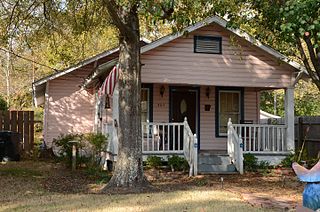
The Oscar Crow House is a historic house at 404 Washington Street in Star City, Arkansas. The single story wood-frame house was built in 1929 by Robert and Doug Verdue for Oscar Crow, owner of a local drug store. The Craftsman style house resembles a shotgun house, but does not exactly follow that form, because its rooms do not progress linearly from the front. The front of the house has a recessed porch supported by box columns, with a vent placed in the gable-end pediment. The front entry is flanked by three-over-one sash windows. The north elevation has four three-over-one windows that are irregularly spaced, and the south side has two such windows, also irregularly spaced. The rear of the house also has a recessed porch. Exposed rafters decorate the roof line.

The Wittsburg Store and Gas Station is a historic retail establishment on Cross County Road 637 in Wittsburg, Arkansas. It is the only commercial building in the community. Built c. 1930, it is a single-story wood-frame structure with a gable roof and a false front. A shed-roof porch extends across the front, supported by for square posts. The main entrance is centered, flanked by sash windows. A gable-roofed section extends from the rear of the building, providing residential space for the shop, which occupies the main block. The building also features a concrete storm cellar, and there is a period gas pump to the building's southeast. The store operated from the 1930s to the 1980s, and is a reminder of Wittsburg's former status as a significant river town.

The Valley Springs School is a historic school building at 1 School Street in Valley Springs, Arkansas. Now part of a larger school complex, it is a single-story fieldstone structure with a wide south-facing facade, and a gable-on-hip roof. There are two entrance pavilions, marked by steeply-pitched gable projections. The left entrance is deeply recessed under a rounded archway, while that on the right, although also recessed, has a flat-roofed pavilion sheltering access to it. Fenestration is provided by groups of sash windows arranged symmetrically across the facade. The school was built in 1940 with funding from the Works Progress Administration, and originally served as the community's high school.

The Cedarville School Building, also known as the Old Rock School, is a historic school building on Crawford County Road 523 in Cedarville, Arkansas. It is a single-story rectangular masonry stone structure, with a deck-on-hip roof and a stone foundation. Its main facade has a recessed entry under a slightly-projecting shed roof, with three banks of sash windows to its left. The school was built in 1931, and initially served as the city's high school. The building now serves as a community center.

Lackey General Merchandise and Warehouse is a historic commercial building at the northeast corner of Arkansas Highway 66 and North Peabody Avenue in the center of Mountain View, Arkansas. It is a roughly rectangular two-story structure, built out of local stone, with a flat roof surrounded by a low parapet. Its main facade faces west toward the Stone County Courthouse, with plate glass windows topped by awnings on the first floor, and four sash windows on the second. The main entrance is in an angle at the street corner, with the building corner supported by a square stone post. Built in 1924, it is believed to be the largest commercial building in Stone County.

Mallett Hall is a historic former hotel building at 2782 Lee Road in Lee, Maine. Built in 1889, it is a rare surviving example of a once-common form, a country hotel in rural Maine. Now owned by the local historical society, it serves as a community function space. It was listed on the National Register of Historic Places in 1993.

The Fayetteville Fire Department Fire Station 3 is a historic fire station at 4140 South School Street in Fayetteville, Arkansas. It is a single story masonry structure, built out of brick in 1963 to a design by local architect T. Ewing Shelton, and is located near the northwest corner of the Drake Field airport. It has two equipment bays on the left, articulated by projecting piers which have narrow windows on the outside. To the right is a lower section, housing a pedestrian entrance and a pair of sash windows. The station is significant as a high-quality local example of Mid-Century Modern design, and for its exemplification of the community's growth in the mid-20th century.
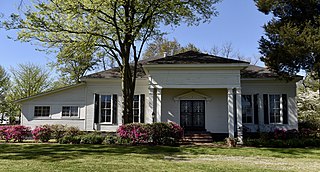
The Wilson Community House is a historic community meeting hall at 10 Lake Drive in Wilson, Arkansas. It is a single-story wood frame structure, with a hip roof, weatherboard siding, and foundation of brick and stone piers. It has Colonial Revival styling, including a hip-roofed entrance portico with groups of supporting Doric columns, and four-over-four sash windows. It was built in 1906, and has served since then as a significant focal point for community events, with an early history including use as a church and school.

Kocourek and Son Hardware is a historic commercial building at 110 East North Front Street in Hazen, Arkansas. It is a two-story brick structure, with commercial Italianate styling typical of the early 20th century. It has two storefronts, each with plate glass display windows and recessed entrances, on the ground floor, and four pairs of sash windows on the second, set in segmented-arch openings. Above this are two bands of brick corbelling, with four brick panels articulated by pilasters, each panel with a wrought iron grill at the center. It house the named hardware store from its construction until 2002, and is the city's finest example of early 20th-century commercial architecture.
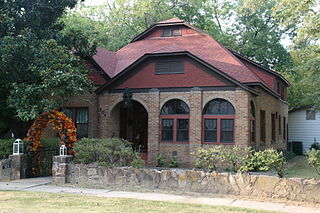
The Michael M. Hiegel House is a historic house at 504 Second Street in Conway, Arkansas. It is a picturesque 1-1/2 story structure, finished in brick and stucco and covered by a gable-on-hip roof. The main facade bays are articulated by brick pilasters, with the two right bays filled with round-arch windows, and the bay to their left housing the main entrance, deeply recessed under a similar rounded arch. To its left is a projecting gable-arched section with a pair of sash windows. Built about 1911, it is a high quality local example of Tudor Revival architecture. It was built by Michael Hiegel, a prominent local businessman who operated a grocery store and lumber business, and was active in local political affairs.
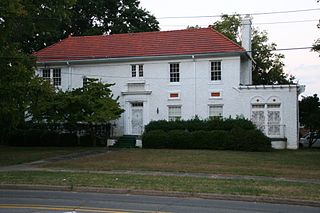
The Reuben W. Robins House is a historic house at 508 Locust Street in Conway, Arkansas. Built in 1928, it is a fine local example of Mission Revival architecture. It is two stories in height, with a hipped red tile roof and a stuccoed exterior. Most of its windows are rectangular sash, but there are a few round-arch windows in the Mission style. The house was built for Reuben W. Robins, a prominent local attorney who also served on the Arkansas Supreme Court.
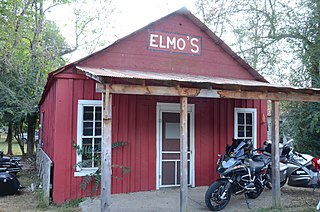
The N.E. Dickerson Store is a historic commercial building on Arkansas Highway 215 in the village of Oark, Arkansas, just west of the Oark General Store. It is a single-story wood frame building, with a gabled roof and a shed-roof porch extending across the front. The front is three bays, with sash windows flanking the entrance. It was built about 1902 to meet increased retail demand in the community, and operated in a cooperative arrangement with the Oark General Store. In the late 20th century, the buildings were both owned by the same family.

The Johnson County Courthouse is located at Main and Fulton Streets in downtown Clarksville, the county seat of Johnson County, Arkansas. It is a three-story masonry structure, built out of brick and rusticated concrete blocks. It has a Classical Revival facade, with a seven-bay projecting section. Windows and entrances on the ground floor are set in round-arch openings, while the upper level windows are rectangular sash, set in bays articulated by pilasters. It was built in 1934 with funding support from the Federal Emergency Administration, and is the county's third courthouse.

The R.L. Leach Grocery Store is a historic commercial building on Dutch Mills Road in Dutch Mills, Arkansas. Built about 1925, it is a single-story structure with a gabled roof and exterior finished in novelty siding. A shed-roof porch extends across the front facade supported by square posts. The facade is symmetrical, with a pair of entrances, each flanked by sash windows. A parapet above the porch roof is adorned with a sign identifying the building. The building site was where the first general store and post office were located in the village of Dutch Mills, when it was first settled by German immigrants in the 1860s. The present building is in part built in 1925 as a replacement for an earlier store destroyed by fire, and in part from a nearby filling station building, which was grafted onto it. In addition to housing the community store, it also served as its post office until 1968.

The Highfill Community Center, formerly the Highfill School, is a historic school building at 11978 Highfill Avenue in Highfill, Arkansas, at its northeast corner with 4th Street. It is a single-story frame structure, finished with wooden clapboard siding and a hip roof. The main entrance is on one of the short sides, sheltered by a hipped hood and flanked by sash windows. The building was constructed about 1911 to serve as a school for district 71, which covered the town. The school was consolidated into the system of nearby Gentry in 1948, and the building was retained for use as a community center, a role it continues to play today.



















